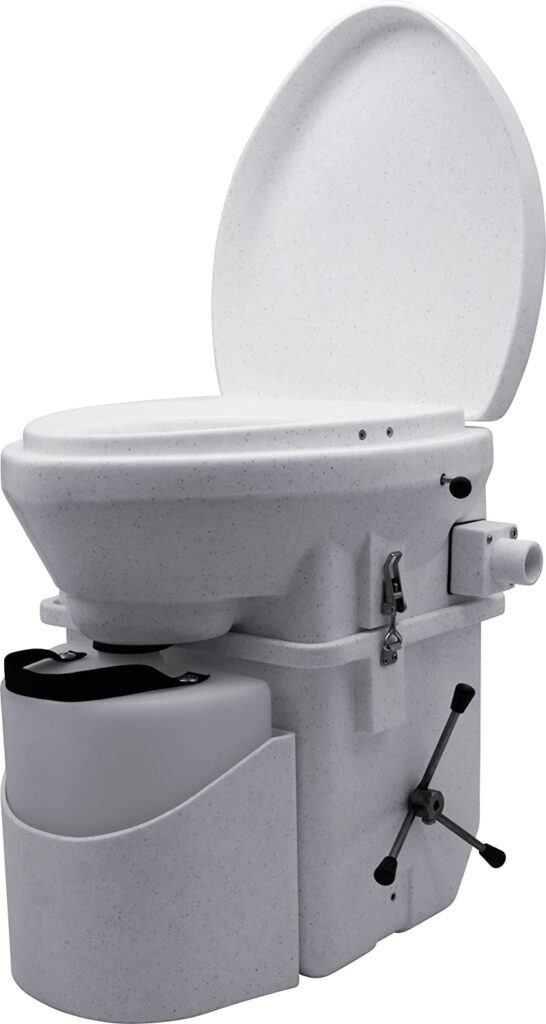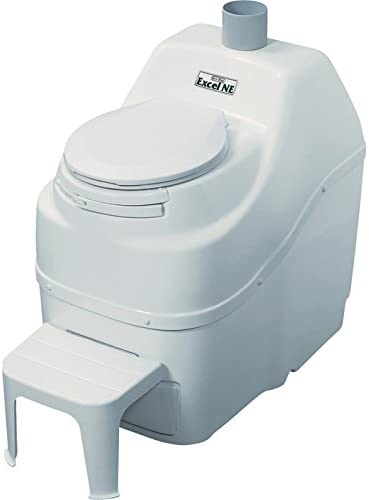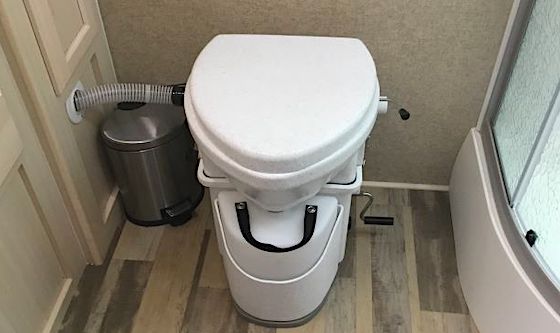Thanks for your support! If you make a purchase using our links in this article, we may make a commission. And, as an Amazon Associate, I earn from qualifying purchases. See the full disclosure here.
With the many kinds of camper toilets that exist today, you may be wondering if a composting toilet for an RV is the best choice. Their design is both unique and innovative, as they do not require water or hookups. Plus, they are easy to empty!
Because you can easily dump an RV composting toilet on your own, campground visits are not required. This advantage makes them perfect for boondocking or living off-grid.
Regardless, you must consider your needs as a camper, as well as your lifestyle, to choose the right kind for you. This guide provides you with insights so you can learn why you should consider a composting toilet for your RV or camper.
How Do RV Composting Toilets Work?
To understand the RV composting toilet basics, you must first know how a standard RV toilet operates. A regular camper toilet feeds into a black water holding tank. Here, the waste is stored until emptied via sewage hose. Therefore, this system works better for those who frequent campgrounds with available hookups.
RV composting toilets, on the other hand, are much different. Through this process, human waste is broken down by decomposition and evaporation. Water makes up the majority and evaporates through the vent system into the atmosphere. Conversely, the solid material becomes usable fertilized soil when it decomposes.
Furthermore, the composting chamber does all the dirty work. It is here that oxygen, heat, moisture, and organic material combine with aerobic bacteria. The interaction between these compounds converts the waste into fertilized soil. All pathogens and viruses are broken down by bacteria during this process, so the soil is sterile and ready for use. By this definition, you can use your waste to grow plants and trees. Crazy, right?
As for the liquid matter, the composting toilet also has this covered. Interestingly, water makes up around 90% of the waste. The system uses an evaporation process to rid the excess and eliminate moisture. Some have a waterless urinal, which is separate from the composting chamber. With this kind, you can manually empty the liquid waste or let it evaporate through the vent system.
Those with internal heating components speed up the process. The warmth helps to remove the water faster without evaporating all of it. The composting chamber needs some dampness to break down the waste. Add bulking material, such as sawdust, peat mix, or popcorn, to promote decomposition. These additives help oxygen flow throughout the debris to remove smelly and toxic bacteria.
RV Composting Toilets Pros and Cons
Like anything, an RV composting toilet has both its strengths and weaknesses. For many, the benefits outweigh the negative aspects of this toilet. Either way, it is crucial to consider each factor before deciding.
Pros of RV Composting Toilets
- No hookups required
- Eco-friendly
- Space-saving
No hookups required. There is no septic system or connection for this toilet, as this entire process occurs in one unit. People who live in remote areas, tiny houses, boats, and cabins also use this no-flush system. It is low maintenance and eliminates worry about stopping at a campground.
Eco-friendly. Did you know that using a composting toilet saves the average family almost 8,000 gallons of water each year? That’s more than an 18′ round swimming pool! These toilets also cut down on the need for sewage plants, which use harmful chemicals to treat raw waste.
Space-saver. Many people enjoy the compact design of RV composting toilets. Without a black water tank attachment, they fit just about anywhere. This sizing makes them perfect for camper bathrooms, which are usually small and difficult to maneuver around. Plus, with fewer parts and mechanisms, repairs are more straightforward. Therefore, you will not have to squeeze into tiny spaces to find leaks or tighten loose screws.
Cons of a Composting Toilet for RV
- Price
- Learning curve
- Requires a bit of power
They are pricier than others. Cost heavily influences this type of decision. Their unique mechanism, which makes them both practical and easy to use, increases their price. However, these toilets are worth the initial cost for most campers because they eliminate the need to use hookups.
You must get used to it. If done correctly, the fertilized product will be free of bacteria and looks just like topsoil. This process grosses some people out, as touching something that was once your waste is undoubtedly an odd concept. But rest assured, the soil is sanitary and safe to handle.
It requires minimal power. The exhaust fan that evaporates water requires a small amount of energy. Many campers fix this problem by hooking their RV composting toilets up to solar power. Otherwise, it will run on a 12-volt battery or 110-volt shore power.
How Much Do RV Composting Toilets Cost?
Understandably, RV composting toilets are a tad pricier than a traditional one. This technology is both new and highly efficient, so their costs make sense. You may cringe thinking about dishing out this kind of money for a toilet. But, surprisingly, it is more cost-efficient in the long term.
Although the initial price is a bit higher, you will save money over time. The average composting toilet will cost around $1000, give or take. The unit built into your camper is much cheaper. However, black tanks will eventually cost you more time and money.
For example, most campgrounds include a 25-50% fee for sewage hookup in their standard rate. Even if you do not stay overnight, they will still charge you to dump. And should I mention the gross and bacteria-ridden process of emptying your black water tank? For these reasons, choosing a composting toilet is much more practical, especially when it comes to dry camping.
Remember that you will still need to visit a campground every so often to dump your grey water tank. Fortunately, these visits are much less frequent, depending on how long and often you use your shower or sink water. With only one or two people, you may be able to last a couple of weeks before you stop. But still, using a composting toilet cuts down on overall campground visits.
Best Composting Toilets for RVs and Campers
When it comes to purchasing a composting toilet, there are a few that outrank the rest. You’re looking for a low-cost system that is both durable and long-lasting. Therefore, these high-quality toilets listed below are the top brands on the market today.
Nature’s Head Composting Toilet For RVs, Campers, Boats, and Tiny Houses

The most popular brand of composting toilets is, by far, Nature’s Head. With their affordability and extended lifespan, they make for a great addition to your camper. Their innovative design allows you to go for about three weeks, or 60 to 80 uses, between empties. They run on a 12-volt, non-battery system and with the proper attachment, you can hook it up to a 110-volt power source. Keep in mind that these toilets do not have drawers, so, to empty it, you must remove the whole assembly.
Furthermore, Nature’s Head toilets come in two kinds, with the only main difference being their handles and seats. The spider handle version only takes up 2 inches of extra space, but it is more difficult to turn. The standard crank handle, on the other hand, is much more natural to turn but takes up five extra inches of room. Both have very similar features and mechanisms, while their cost ranges from $925 to $960.
Sun-Mar Composting Toilet for RVs

Sun-Mar is another brand to consider. They are quite pricey, starting around $1645 due to their added capabilities. With a waste emptying drawer and electric hookup power, they include more features than others. These composting toilets are also much more cumbersome, weighing in at 90 pounds. Note that they do not easily connect to a 12-volt system. For these reasons, they work best in a tiny home or cabin.
Do I Need Special Toilet Paper for RV Composting Toilets?
Primarily, toilet paper comes from three types of materials – trees, recycled paper, or other materials, like bamboo and sugarcane. Composting toilets best tolerate recycled paper. It breaks down faster and more effectively due to its thinner fibers. Lesser known, toilet paper also acts as a source of carbon during the decomposition process. Therefore, using it in your composting toilet may prove to be beneficial.
Like a black water tank, only use RV-safe toilet paper in your camper. It breaks down much better, especially when combined with additives. The tissue does not break down as quickly, so you will see it when dumping. Note that one-ply disintegrates quicker than two or three. We use Aqua Soft Toilet Paper in our RV and recommend that you use it too.
Some campers do not add their toilet paper to the chamber. Instead, they have a separate waste container for the used tissue. This way, the tank fills slower, allowing the user to go longer between dumps. Do not put items, such as wipes, diapers, and tampons, down the toilet. These items do not decompose, as they are made from non-organic cotton and contain chlorine-bleach.
How to Prep and Dump an RV Composting Toilet
Every user needs to know how to properly prep their RV composting toilet. Always clean and prepare just after dumping to ensure the quality of the system.
To Prepare the Toilet:
- Gather two liters of water, gloves, a shovel, a bucket.
- Take off the top off, then fill a bucket with two one-gallon Ziploc bags of sphagnum peat moss or coconut fiber.
- Add one and a half to two liters of water and combine.
- Next, dump the mixture into the toilet and fill to just below the agitator.
- Put the lid back on, and you’re ready to go!
Now, for the fun part – emptying. When done correctly, the composting toilet will eliminate any bacteria. However, you should always use gloves to protect yourself from any lingering germs. Once you get used to the emptying process, it should only take a few minutes. The more frequent you empty, the fewer problems you will have.
First, let’s start with the liquids. The bottle holds about 2.2 gallons, but you should empty it when it reaches about two-thirds full to prevent any unpleasant accidents. On average, it takes about three or four days for two people to reach this limit with regular use. If the urine sits for long periods, it will smell strong and putrid. Keeping a second holding bottle on hand helps when you cannot dump, but the tank is full.
To Empty the Liquids:
- Take off the seat and lift the toilet to a 45-degree angle.
- Pick up the handle, put on the cap, and pull out the container.
- Dump the liquids in an area that is legal and safe, such as a public toilet.
- Rinse the bottle with vinegar or detergent and put it back in the composting toilet.
- Put the seat down, clean up, and you’re all set.
Let’s move to the solids. Try to turn the handle on your composting toilet. If you find it difficult, then it’s time to dump the compost. You will also know to dispose of the waste when the base reaches three-fourths full.
It is best to dump the tank in the morning so the compost can sit overnight. You should wait at least eight hours after using the bathroom to empty it, giving it time to decompose. Emptying the tank is relatively simple, as it does not smell and takes only a few minutes. Without further ado, throw on your gloves and start dumping.
To Dump the Solids:
- Quickly remove the lid and take out the liquids bottle. Cap it to prevent spillage. Put the top back on.
- Disconnect the vent hose and power cord, unscrew the bolts, and take the entire toilet outside.
- Take off the seat, again.
- Place a 13-gallon trash bag, or composting bag, over the top. Flip the unit and dump the contents.
- Prep the base using the process stated above. Do not worry about cleaning the inside of the chamber, as the decomposition process will take care of it.
- Bring the toilet inside and reconnect the vent hose and power cord.
- Put the liquids bottle back in, then place the lid back on.
And that’s it! You’ve emptied both your liquids and solids and prepped for your next dump. The process is actually much easier than connecting your black water tank to a sewage hookup. Overall, it is more sanitary and takes less time. Plus, you don’t need to find the nearest campground to dump. Easy as that!
Do RV Composting Toilets Smell?
When people think of composting toilets, they automatically associate them with gross and smelly waste bins. Ironically, it is quite the opposite. If used correctly, these toilets are free from harmful, odor-producing pathogens. Many argue that composting toilets smell even less than other types of RV toilets.
There are a few reasons that composting toilets cut down on the stink. First, a ventilation fan pulls air from the bathroom into the tank. This system then feeds to the outside of the RV. These vent stacks eliminate odors using negative pressure, which strictly forces the air outward.
Second, compost starters also help to restrict foul smells and promote the decaying process. These accelerators consist of nitrogen, oxygen, micro-organisms, and shredders (i.e., paper products and wood chips). This mix destroys bacteria and breaks down the waste into functional soil.
Plus, if you’re a coffee drinker, you’re in luck! Adding leftover coffee grounds into your composting toilet will further cover the smell. The coffee grinds also function as additional bulking material to break down the waste.
Lastly, you can also mask the stench by purchasing a spray bottle designated for the toilet. Fill it with a water and vinegar mixture, then spray the inside after use. Some use vinegar as a natural housecleaning remedy due to its antimicrobial effects. You can also add essential oils to give the bathroom a refreshing scent.
Avoid putting regular soil or material into your composting chamber at all costs. By doing so, you are inviting pesky insects into your camper. They are tough to get rid of and can ruin your camping experience. Instead, purchase regulated bulking material. It is worth the cost to reduce the issues you may face later.
RELATED READING: Most folks that boondock find composting toilets useful. To find some great places for boondocking check out our article How To Find Free RV Camping.
Conclusion
There are many benefits to these toilets, especially for those who enjoy living off-grid. With a bit of practice, the process is rather simple and eliminates the need to use hookups. So, are you ready to ditch your old routine and install a composting toilet in your camper?
Do you use a composting toilet and have any tips to share? Please leave your comments below!
For more info please check out some other of our articles below too.
- 8 Best Small Camping Trailers with Bathrooms
- 21 Must-Have RV Accessories for a New Camper or Travel Trailer
- Can I Live in an RV on My Own Property?
- How to Install RV Hookups at Home
- RV Black Water Tank Cleaning Tips
- 7 Best Pop Up Campers with Bathrooms
- Can I Dump RV Tanks at Home?



Should it be any different if overwintering in an RV in cold climates?
This was SOO insightful! I’m a soon-to-be RV-er and strongly considering a composting toilet – mainly for environmental and lazy reasons. 🙂 I appreciate all the information.
Thanks Eva!
Glad you found the article to be informative!
Mike